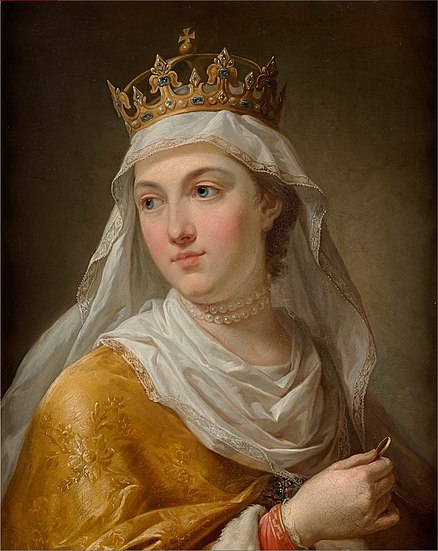 In 1370, King Louis I of Hungary also obtained the crown of Poland, thereby binding the titles together in personal union. He wanted to produce a son who could inherit both kingdoms and thereby keep them united. His only child, a daughter, had died as an infant back in 1365, and, as Louis was already approaching 50, there was concern that he may not be able to produce an heir at all. Luckily, having an additional crown seems to have improved his confidence in the bedroom, and his wife Elizabeth had three quick children - Catherine in 1370, Mary in 1371 and Hedwig in 1374. All daughters.
In 1370, King Louis I of Hungary also obtained the crown of Poland, thereby binding the titles together in personal union. He wanted to produce a son who could inherit both kingdoms and thereby keep them united. His only child, a daughter, had died as an infant back in 1365, and, as Louis was already approaching 50, there was concern that he may not be able to produce an heir at all. Luckily, having an additional crown seems to have improved his confidence in the bedroom, and his wife Elizabeth had three quick children - Catherine in 1370, Mary in 1371 and Hedwig in 1374. All daughters.Louis set about negotiating an agreement with the nobility that would allow a daughter to inherit his titles should he die without a son. They came to a deal by which one of his three daughters, to be chosen by him, his wife, or his mother, would be the new monarch on his death.
This made the three girls the most sought-after brides in Europe. At the age of four, Catherine was promised to the son of the King of France. Also at age four, Hedwig was betrothed to the Habsburg family heir. Mary got the worst end of the deal, and was engaged to her first cousin when she was one year old. This was pretty weird even for the time period, and required Papal approval. Figuring that if God had such a problem with this then maybe He should have given Louis a son in the first place, the Pope decided to give them the go-ahead.
After Catherine died in 1378 and Louis in 1382, Mary and Hedwig were left to inherit. Initially their mother Elizabeth wanted Mary to rule over both countries, but the Polish nobles didn't want to remain in union with Hungary. After much negotiation and a splash of civil war, it was agreed that Mary would rule in Hungary while the Polish crown would pass to Hedwig.
There was just one little problem. The laws of Poland required a king - there were no provisions for a queen to rule. Luckily, just as there is no rule saying a dog can't play basketball, there was no rule saying a ten-year-old girl couldn't be king. So, on October 16, 1384, Hedwig was crowned King of Poland.
After reaching adulthood, Hedwig excelled at being king. She personally led two successful military campaigns to recover lost Polish territory, handled diplomatic negotiations with the neighboring Teutonic Order, and restored the university in Krakow. She spoke at least six languages and was known for her knowledge of the arts and sciences.
King Hedwig died during childbirth at the age of 25, but continued to be revered by the people of Poland. She was later canonized as a Catholic saint, and is considered, ironically, the patron saint of queens.
No comments:
Post a Comment